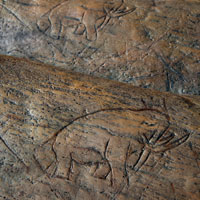 Ancient Vero bone to get DNA test at Smithsonian lab’
Ancient Vero bone to get DNA test at Smithsonian lab’
STORY BY SANDRA RAWLS, (Week of September 22, 2011)
Smithsonian Institute scientist Thomas Jorstad is headed to Vero Beach Friday to pursue still more testing of the now legendary etched prehistoric bone found here, believed to contain the oldest piece of art in the Americas.
A special drill will remove a sliver of the heavily mineralized bone which will then be packed up for the trip back to Washington, D.C. There, in a clean room environment at one of the Smithsonian Institution’s state of the art labs, the shaft of bone may give up important new secrets.
Ancient DNA and Mitochondrial DNA are now routinely harvested from bones for studies ranging from investigating old homicides to the mysteries of animal and human evolution, migration and changing ecological conditions.
The newest methods for extracting the ancient molecules may tell us exactly what type of extinct animal the old bone came from. Did the man or woman who carved the much-studied image of a mammoth or mastodon use a forelimb or rib from that same animal, or was it from a ground sloth or another big mammal no longer here?
The hope is that DNA might have survived from microorganisms present in the animal when it died or from other microbes that lived in its body. The molecular data can also sometimes be used as a type of clock, based on the rate of changes that can occur in genetic material.
Nothing is assured in this new, cutting-edge technique.
Ancient DNA is easily contaminated and often of poor quality. Several years ago, well-known geo-chemist and fossil-dating specialist Tom Stafford, Ph.D., tried to find fossil DNA in a mammoth tooth from Vero. He was unsuccessful. Nothing may remain in the old bone of the sought after molecules Jorstad hopes to find.
Scientific furor over the artifact with the elephant image continues unabated since results of research by the University of Florida pointed to authenticity of the carving in June 2009.
Since then, much as been learned about the bone and its faint, distinctive elephant etching. Last month, Jorstad and others wrote an article in the prestigious Journal of Archaeological Science that combined work done at UF with work at the Smithsonian Institution.
They reported that rare element analysis confirmed the great age of the bone and its origins in Vero Beach. The analysis results lay to rest the question of whether the foot-long bone is a remnant from the end of the ice age in Vero. Indeed, that the animal was here when it died.
The article further outlines the tests both institutions have done into the possible age and authenticity of the carving. All revealed nothing to indicate the three-inch carving of the mammoth is anything but genuine and very, very old.
The new science adds to the growing likelihood the carving represents the oldest and only existing example of late Pleistocene art depicting an extinct animal found so far in the Western Hemisphere. Interest in additional types of testing and other questions linger however.
The murky context for the exact geological situation the bone was in when discovered may never be completely clarified.
Artifact owner, amateur Vero Beach fossil hunter James Kennedy, is unwilling to reveal exactly where in town the bone was found. He will only describe it as private land just north of the center of town. The bone sat in a box under the sink for a year or two before cleaning and closer examination revealed the carving.








